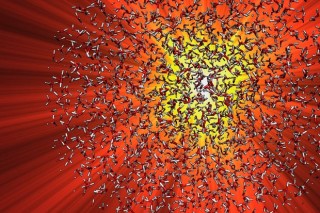CUI scientists have devised a novel way to boil water in less than a trillionth of a second. The theoretical concept, which has not yet been demonstrated in practice, could heat a small amount of water by as much as 600 degrees Celsius in just half a picosecond (a trillionth of a second). That is much less than the proverbial blink of an eye: one picosecond is to a second what one second is to almost 32 millennia. This would make the technique the fastest water-heating method on earth.

A single terahertz-flash can heat up water to 600 degrees Celsius. Foto: DESY/Oriol Vendrell
The novel concept opens up interesting new ways for experiments with heated samples of chemical or biological relevance, as the inventors report in the scientific journal Angewandte Chemie – International Edition (Nr. 51, 16 December 2013). “Water is the single most important medium in which chemical and biological processes take place,” explains Dr. Oriol Vendrell (CUI, DESY) “Water is not just a passive solvent, but plays an important role in the dynamics of biological and chemical processes by stabilising certain chemical compounds and enabling specific reactions.”
All it takes for superfast water heating is a concentrated flash of terahertz radiation. Terahertz radiation consists of electromagnetic waves with a frequency between radio waves and infrared. Terahertz flashes can be generated with devices called free-electron lasers that send accelerated electrons on a well defined slalom course. The particles emit electromagnetic waves in each bend that add up to an intense laser like pulse. The terahertz pulse changes the strength of the interaction between water molecules in a very short time, which immediately start to vibrate violently.
The scientists calculated the interaction of the terahertz flash with bulk water. The simulations were performed at the Supercomputer Center Jülich and used a total of 200,000 hours of processor time by massively parallel computing. On a single processor machine this would correspond to about 20 years of computation. “We have calculated that it should be possible to heat up the liquid to about 600 degrees Celsius within just half a picosecond, obtaining a transiently hot and structureless environment still at the density of the liquid, leaving all water molecules intact,” says Vendrell.
The novel method can heat about one nanolitre (billionth of a litre) in one go – enough for most experiments. For comparison, ink-jet printers fire droplets that are as small as one picolitre, which is a thousand times less than a nanolitre.
“The idea is to heat-up the ‘solvent’ so that many molecules start the desired chemical process at the same time and then watch the reaction evolve,” explains Vendrell, who worked out the super heater with co-authors Pankaj Kr. Mishra (CUI Graduate School) and Prof. Robin Santra (CUI, DESY). Although the hot mini-cloud will fly apart in less than a millisecond (a thousandth of a second), it lasts long enough to unravel everything of interest in thermal reactions such as the combination of small organic molecules to form new substances. The team currently investigates how the intense pulse of terahertz radiation affects different types of molecules dissolved in water, from inorganic to biological systems.
The reaction progress can be probed with ultrashort X-ray flashes. One advantage of the heating method is that the terahertz pulse can be very well synchronised with the X-ray flashes to start the experiment and then probe the reaction after a well defined time. “The transient and hot environment achieved by the terahertz pulse could have interesting properties, like a matrix to study activated chemical processes,” says Vendrell. “This will be the subject of further investigations.”
Reference:
“Ultrafast Energy Transfer to Liquid Water by Sub-Picosecond High- Intensity Terahertz Pulses: An Ab Initio Molecular Dynamics Study”; Pankaj Kr. Mishra, Oriol Vendrell and Robin Santra; Angewandte Chemie – International Edition (2013); DOI: 10.1002/anie.201305991

